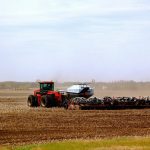In late June, adzuki beans that had been in the ground for 3 weeks already had a few nodules on the roots (see photo at top), and the nodules were […] Read more
Chickpeas

Nodulation and nitrogen use in dry beans
OMAFRA Field Crop Report for the week of July 1

U.S. pulse area tops early intentions
Farmers in the United States planted considerably more pulse crops in 2024 than originally projected, according to updated acreage data from the U.S. Department of Agriculture released June 28.

Pulse Weekly: Outlook for chickpeas is good
Canadian chickpea acres are most likely going to increase in Statistics Canada’s planted acreage report due out on June 27, according to Colin Young of Midwest Gran Inc. in Moose Jaw, Sask.

Alberta Crop Report: Variable weather fails to dispel crop growth
Crop conditions across the province were rated at 72.9 per cent good to excellent, better than the five-year average of 68.8 per cent and the 10-year average of 70.2 per cent. The central region had the best rating at 78.2 per cent, followed by the Peace region at 75.7 per cent and the south region at 73.9 per cent, all above both historical averages. The northeast region was at 70 per cent, below its averages, while the northwest was in line with its average at 61.8 per cent.

AAFC raises wheat exports call, tightens carryout
Canadian wheat exports in both the current crop year and the upcoming 2024/25 marketing year will likely end up above earlier expectations, according to updated supply/demand estimates from Agriculture and Agri-Food Canada (AAFC), released June 20, that left the balance sheet for canola relatively unchanged.

Pulse Weekly: Crops growing well in Saskatchewan despite rains
As of June 10, seeding was 98 per cent complete in Saskatchewan according to the province’s weekly crop report. Also, 79 per cent of pulse crops were in normal development, while 19 per cent were behind and two per cent were ahead. Lentils were rated 90 per cent good to excellent, while chickpeas were rated at 95 per cent. Field peas were rated at 91 per cent good to excellent, while soybeans were at 83 per cent.

Saskatchewan spring planting virtually complete
At 98 per cent complete, spring planting in Saskatchewan has essentially wrapped up for 2024, although for rain has delayed farmers’ last rounds in the northeast and east-central regions of […] Read more

Pulse weekly: Canadian pulse exports slowing
Glacier FarmMedia – Canadian pulse exports are showing signs of slowing down entering the final months of the 2023/24 marketing year, as end users turn their attention to the looming […] Read more

Seeding very close to wrapping up in Alberta
Spring planting in Alberta has almost wrapped up for this year, with the agriculture ministry pegging it at 97 per cent complete province-wide as of June 4. Seeding advanced 20 […] Read more

Pulse Weekly: Increased Australian production could pose greater export challenges for Canada
The Australian Bureau of Agricultural and Resources Economics and Sciences released its monthly supply and demand report on June 3. The report showed a 57.2 per cent increase for Australia’s chickpea production at 1.15 million tonnes in 2024/25. The country’s lentil output is to change very slightly with a dip of a mere 2,000 tonnes from a year ago at 1.61 million.
